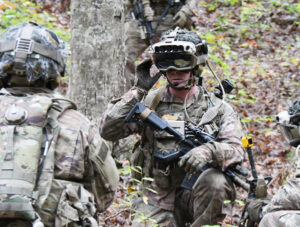A new Request for Information released Wednesday details the Army’s interest in industry’s capabilities for developing and integrating artificial intelligence (AI) and machine learning (ML) solutions for its future augmented reality headsets.
The RFI is seeking industry’s input on experience with AI and ML features that could be applied to the Integrated Visual Augmentation System (IVAS), such as AI-enabled target detection and multi-sensor data collection.

In the call to industry, the Army notes IVAS is designed to provide soldiers with “movement of information, high level processing, and displays augmented reality information,” to include sharing coordinate terrain and mission planning data backed up by AI/ML-enabled processing.
Additional AI and ML-related areas the Army is looking to apply to IVAS include battlefield data processing, mixed reality soldier interface solutions, AI-assisted 3D reconstruction, machine-assisted mission planning, assistance for GPS-denied navigation and human-machine teaming for unmanned vehicle mission planning, according to the RFI.
The Army is also interested in AI and ML solutions to enable soldiers to use IVAS for swarming miniature drones for persistent surveillance and identifying areas of limited mobility and terrain bottlenecks in woodland and urban environments.
Last March, the Army awarded Microsoft [MSFT] a deal worth up to $21.9 billion over the next 10 years to move the IVAS program from rapid prototyping into production (Defense Daily, March 31).
In October, however, the Army confirmed it was delaying the IVAS’ operational evaluation to next May and pushing back the first unit equipped date to September 2022 (Defense Daily, Oct 14).
Karen Saunders, the Army’s acting top acquisition official, and Gen. Mike Murray, the head of Army Futures Command, then released a joint statement acknowledging an issue with the system’s waveguide technology that was causing resolution issues.
The Pentagon’s inspector general then announced plans to conduct an audit of the IVAS program “to determine whether Army officials are producing and fielding Integrated Visual Augmentation System units that meet capability requirements and user needs.” (Defense Daily, Oct. 19).